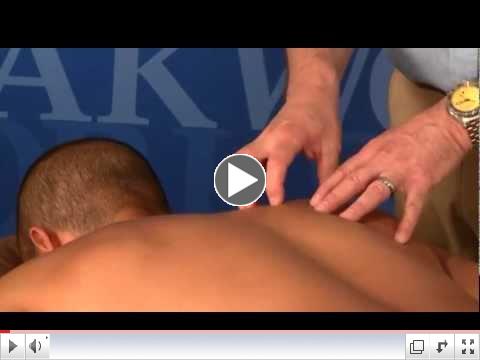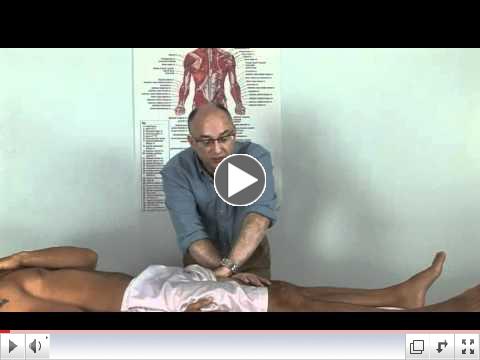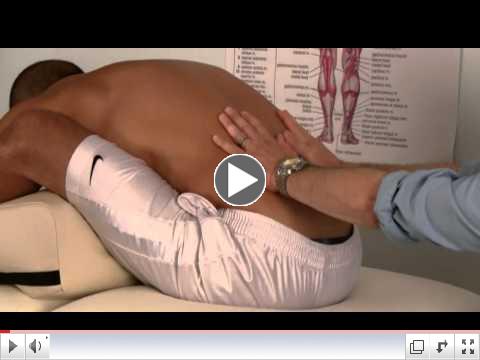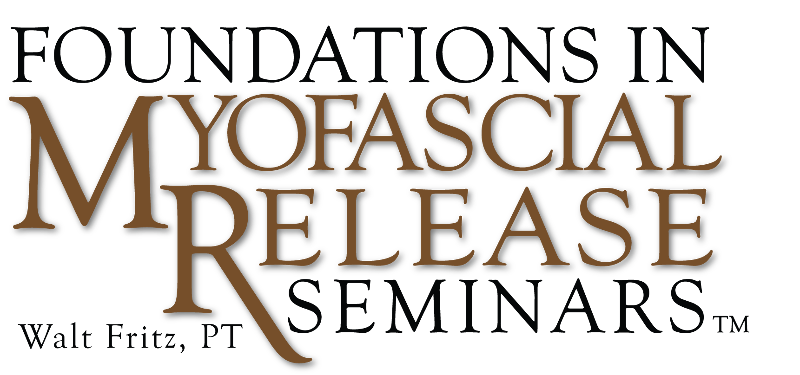 Walt Fritz, PT
Walt has been a Myofascial Release practitioner since 1992 and has been teaching since 1995. His Foundations in Myofascial Release Seminars are presented in small group settings with highly individualized one-on-one attention. Join him for a "New Perspective" on Myofascial Release.
|
 | | Leveling the Landscape of the Thorax |
 | | Myomobilization with Myofascial Release for the Thigh |
 | | Compressive Myofascial Release for the Foot |
 | | Lumbar Lift |
|
|
|
 |
What's New?
Hi Everyone, Many of you I've met over the past few years while traveling the country. I've had a chance to share my approach and technique for Myofascial Release, one that certainly has evolved and continues to do so. Many of you may remember which techniques I've said were my favorites and I would love your feedback on how things have worked using these techniques. My two "go-to" techniques for neck pain and lower back pain are the following:  | | Cervical Thoracic Lift |
 | | Anterior Lumbar Myofascial Release |
The Cervical/Thoracic Lift has taken a front row in my treatment of upper thoracic, cervical, and occipital region pain syndromes. The ability to directly both assess and treat the local nerve tissue, as well as surrounding soft tissue, has made it my most successful upper body technique. The Anterior Lumbar Technique, and also combined with sacral traction, makes up approximately 75% of my lower back and pelvic pain technique. How about you? Have you had success with these (or other) of the techniques and core concepts you learned either by attending a Foundations in Myofascial Release Seminar or by viewing the videos? If you have any comments, please do so on the Myofascial Release Blog. Walt Fritz, PT
|
|
If you enjoy the MFRmail Newsletter, please forward to a friend.
It makes no sense to keep this to yourself... | |
 |
Check out the Visible Body App for the iPad and other devices. One of my favorite anatomy guides and it is fully interactive. Just click the Visible Body symbol above to read all about it.
|

Upcoming Seminars
Myofascial Release...Demystified
Foundations in Myofascial Release Seminars has been chosen to present at the 2013 World Massage Conference (August 4-7, 2013 in Long Beach, CA). Join us aboard the Queen Mary!
Foundations I
Ottawa, Illinois
March 22-24, 2013 Sponsored by: Two Rivers Bodyshop Rochester, NY
May 4-6 Special pricing for this private class, please email for details. Philadelphia (Chadds Ford), PA
May 17-19, 2013 Sponsored by: Institute for Therapeutic Massage and Bodywork, Inc.Boston, Massachusetts June 14-16, 2013 Sponsored by: Cortiva Institute, Boston CampusDallas (Flower Mound), Texas
July 12-14, 2013 Sponsored by: Institute of Bodywork StudiesLong Beach, California
(World Massage Festival 2013)
August 5-7, 2013 Syracuse, New York
September 13-15, 2013 Sponsored by: The Onondaga School of Therapeutic Massage/Syracuse CampusCharlotte (Cornelius), North Carolina
September 27-29, 2013 Sponsored by: NC Massage School Foundations II(NO prerequisite required)
Canton, Ohio
October 25-27, 2012 Sponsored by: Stark State CollegeEnglewood, Florida
April 12-14, 2013 Sponsored by: The Open StudioLafayette, Indiana
August 23-25, 2013 St. Simons Island, GeorgiaOctober 11-13, 2013 Sponsored by: A Balancing Act Listening With Your Hands Myofascial Release for Speech-Language Pathologists A special class that I will be co-teaching with Benjamin Asher, MD. Chicago, Illinois April 27-28, 2013 All Foundation in Myofascial Release Seminars are 20 contact hours/over two and one-half days and it are packed with techniques, theory, and practical application. Building upon a deep model of evaluation, you will leave this seminar ready to use Myofascial Release on your first day back to work. Developing the "Feel" for soft tissue restriction and connecting this to your patient's pain is an essential element missing in other lines of MFR education. Foundations Seminars delves into learning the "Feel", making you a more effective therapist. NCBTMB CE hours continuing education credits are approved. Physical Therapy CE Hours are available in many circumstances, as well as CE Hours for other professions available; please inquire. For full details and to register, please refer to the Seminars Page of the website. You have many options when it comes to continuing education training. Myofascial Release is a powerful modality for eliminating pain and restoring function, but how do you choose? Foundations Seminars draw strongly Walt Fritz's background as a physical therapist, as well as a Myofascial Release practitioner. He has been a New York State Licensed Physical Therapist since 1985 and has been practicing Myofascial Release since 1992. He spent 10 years teaching nationally with other well-regarded practitioners and started his own seminars in 2005. Foundations in Myofascial Release Seminars delve deeply into the evaluation of soft tissue dysfunction from both a more traditional fascia perspective as well as looking at pain through the lens of neuroscience. Through deep evaluation you will explore postural and movement pattern disorders. Treatment then proceeds in a logical manner. It is important to know your strengths as both a therapist and teacher. Walt's strengths lie in his ability to effectively connect his students with the "Feel" of soft tissue restriction and its elimination. Using a gentle approach, he eliminates the need for aggressive work, which is hard on both the patient as well as the therapist. He has taken the work he was taught and moved in a direction of logic and simplicity, without the heavy trappings of New Age teachings. Learning is an ongoing process for all of us, and Foundations Seminars follows this trend. We review all relevant explanations for pain and dysfunction, from the more traditional models of "fascial restriction" to newer models based on scientifically accepted pain theory. Neuromodulatory treatment is introduced along side myofascial release. The overlap is at times quite amazing! All Foundations Seminars attend to the individual needs and background of all participants. The intended audience includes massage therapists, physical therapists, occupational therapists, speech and language pathologists, nurses, chiropractors, and physicians. Instruction is in a very approachable and interactive style. Small class size guarantees individualized one on one attention. The incorporation of a deep model of evaluative understanding regarding the nature of dysfunction within the body aids in connecting the theory of Myofascial Release to the application of treatment. You will leave Foundations I Seminar prepared to use Myofascial Release from your first day back at work. Walt makes himself available for follow up consultation as needed, so you never feel alone in this process. Foundations Seminars are packed with technique, theory, and evaluation. There is considerable lab time where you will get plenty of one-on-one instruction, assuring you to have a positive learning experience. Foundations in Myofascial Release Seminars provide explanations for the workings of myofascial release from both the bio mechanical model, as well as introducing neurobiological explanations. Foundations in Myofascial Release Seminars emphasize a solid orthopedic basis for evaluation and treatment, small group trainings, and a high degree of one-on-one interaction; does this sound like what you are seeking? Myofascial Release...Demystified. I have found myofascial release to be the most effective method for both finding the causes of pain, as well as eliminating them. My goal is to pass this along to you. Walt Fritz, PT | |
If there were one map of the body for all to follow, a map that showed all areas of injury, trauma, and pain, along with the necessary route to take to eliminate those issues, life would be simple.
I received a new GPS this past Christmas. My old GPS had become unreliable due to a few quirks and I did not have full trust in my iPhone's GPS, given a few wrong turns along the way. While my new GPS offers me nearly a nearly foolproof ability to find my way around while traveling, it lacks in some key areas. I learned this a few years back, while traveling to teach one of my Foundations in Myofascial Release Seminars. My hotel was not terribly far from the seminar venue, but each morning and night, I followed the female mechanical voice on my GPS, dutifully turning when she told me to turn. Prior to this, I had always carried a map while traveling and studied it beforehand, as well as before venturing off on a new destination. While near the end of my trip, my old GPS began exhibiting one of its quirks and forced me to find my own way. After spending nearly 4 days in that city I realized that I had no idea how to get to where I wished to go, even though the distance was small. I had previously relied on some internal ability to see a place on an internal map in my mind. I did find my way to my destination eventually, but it was a very good lesson to me.
In order for us to benefit from a map, we need to decide on our route preferences. What factors go into deciding which road to take? When one initially programs a GPS, it will query you to see if you wish to prioritize shortest distance, shortest time, avoiding highways, etc. However, I think most of us forget about these variables each time we plunk in our destination and follow the voice. If we are reading an old-fashioned paper map, we have choice that is more overt; highway or country road, scenic route or "just get there". If we are curious, we may choose a route that takes us past places of interest.
Choosing a map to follow in the body is no different. Many maps are offered, from the ones we learned in school, which tended to be more simplistic, the maps offered through continuing education, and the ones offered by our own experience. I learned a map of the body and followed this map for many years. That map stated that the body behaved in very specific ways. This method was influenced by the theory that fascia was the "great unknown" when it came to unresolved pain. The mysteries of the fascia were there for anyone to perceive, if you only chose to follow the teacher who taught this work. Sounds a bit mysterious, does it not? My introduction to myofascial release was explained in a manner that made sense, at least from my very superficial level of understanding, as well as cherry picking the available evidence to suit my needs. It really lacked any plausibility from a scientific perspective, but I skipped over any lingering questions I might have, as what I learned to do with my hands was incredibly effective. Occasionally my instincts caused me to question my teachers, but the all-important "results" quickly put any doubts to rest! I know now that much of what I learned was either outdated or wrong. In essence, I became a good listening and follower, but not a good questioner. I began applying the principles with my patients and quickly began to notice things that seemed more important to me that did to my teacher, and things my teacher thought were important mattered less to me. Sounds like maturation, correct? What was apparent to me was that dysfunctional tissue (non-specific tissue), presented with a characteristic density that was easily palpable. At first I attempted (rather successfully, I thought) to equate this density to "fascial restriction", as that was what I was taught. However, over time, the "Feel" became the most important element. Fast-forward a decade or two. A few years back I began to expose myself to a neuroscience approach to pain; one that used basic neurology to explain the changes we feel with bodywork. I at first rejected this as skeptical nonsense; how could the results I saw with MFR be wrong? The results were not wrong, just the explanation. The transition from an old-school mentality of myofascial release to embracing these newer concepts was not difficult, as under my hands I still felt what I had felt in the past. Only now, I had much more plausible explanations to use.
The maps that I now use are based on simple anatomy and mostly neuroanatomy. It is not sexy stuff, like other explanations of body work and MFR, and doesn't try to bridge any chasms between body work and parts of the process that we, as body workers, have no business addressing. I am a huge fan of the Visible Body app. While it can be purchased in modules, the Visible Body Atlas is a comprehensive guide to the body and will be the map we use.
For those of you with an enlightened sense of feel, learning this new form of myofascial release work will come easily. The most difficult part may be asking yourself to put aside your beliefs on how best to make changes in the body. Over the past 20 years, I have lightened my touch considerably and enlightened my mind even more. I do not work to any level of uncomfortable depth and never elicit pain.
There are those who feel that the term "myofascial release" is so scientifically incorrect and unrealistic that it should be abandoned. While I believe we are influencing much more than just the fascia, and that fascia is not the magic tissue it has been made out to be, I do feel there is logic in sticking with it, if nothing more than the name recognition value. Ultimately, I will not try to convince you of anything; your process may be as long and tortuous as mine was. In the end, I hope that you simply come away with a better ability to help someone in pain. That is where we start.
The new myofascial release differs little when it comes to what we do with our hands. But it differs wildly with what we do with our minds. Enjoy!
Walt Fritz, PT
|
|
|
Sponsoring a Foundations in Myofascial Release Seminar
Foundations Seminars are dedicated to providing quality small group setting continuing education workshops. Using a sponsorship model has brought seminars to smaller cities that are typically skipped by the larger companies. If you have an interest in bringing a Foundations Seminar to your town, I would love to talk. Seminar sponsoring brings attention to your practice and allows you to build a reputation in your community. Also, you will share a percentage of the registration fees and attend the seminar for free. If you would like more information, refer to this page of the website, then email me or call at 585-244-6180. | |
|